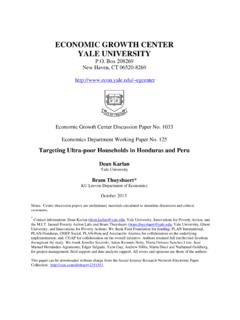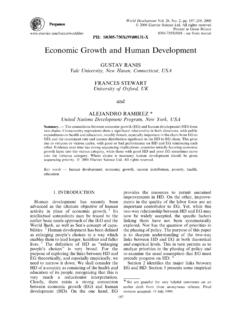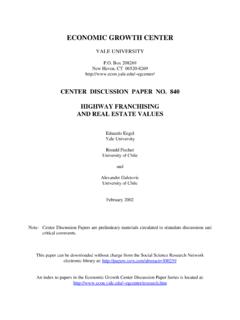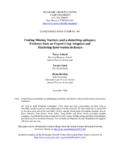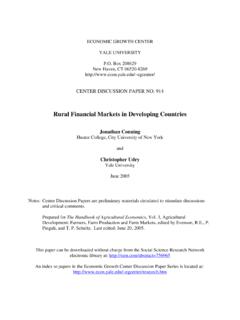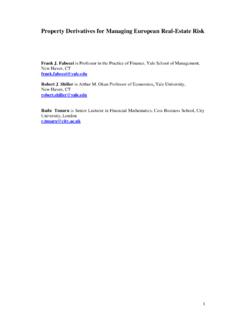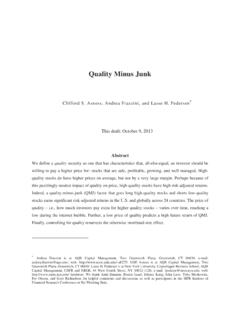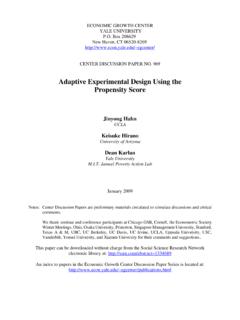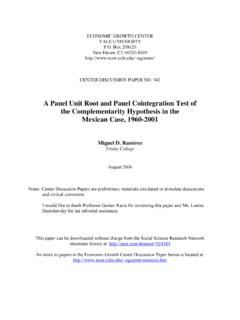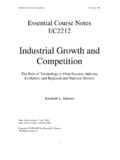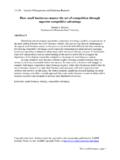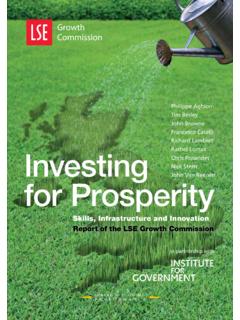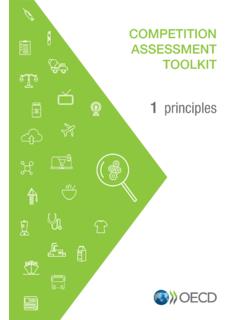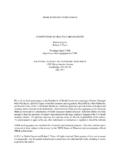Transcription of Arthur Lewis's Contribution to Development …
1 ECONOMIC GROWTH CENTERYALE Box 208629 New Haven, CT 06520-8269 ~egcenter/CENTER DISCUSSION PAPER NO. 891 Arthur lewis Contribution TODEVELOPMENT THINKING AND POLICYG ustav RanisYale UniversityAugust 2004 Notes: Center Discussion Papers are preliminary materials circulated to stimulate discussions andcritical paper can be downloaded without charge from the Social Science Research Network electroniclibrary at: index to papers in the Economic Growth Center Discussion Paper Series is located at: ~ lewis Contribution to Development Thinking and PolicyGustav RanisYale UniversityAbstractArthur lewis seminal 1954 paper and its emphasis on dualism appeared at a time whenneither the work of Keynes or Harrod-Domar nor the later neoclassical production function of Solowseemed relevant for developing a consequence, his model, rooted in the classical tradition, plus its many extensions,generated an extensive literature at the center of Development theory.
2 The approach alsoencountered increasingly strong criticism, some of the red herring variety, but some, spearheadedby neoclassical microeconomists like Rosenzweig, also raised serious challenges, focused especiallyon its labor market paper reviews this landscape and asks what theoretical or policy relevance the Lewismodel retains for today s developing : Development Theory, Dualism, Labor MarketsJEL Classification: O11 3 Arthur lewis Contribution to Development Thinking and Policy* Gustav Ranis Yale University 1. Introduction As is well known, the rebirth of the sub-discipline of Development economics coincided more or less with the early post-World War II era.
3 It is also relevant to recall that this revival of Development theory and policy heavily emphasized the breaking of colonial ties which were associated, somewhat erroneously, with the workings of the market and, consequently, placed major emphasis on the role of the state in the newly independent countries of the Third World. Unfortunately, the tool kit available to Development economists of the day was also fairly limited. On the one hand, there was the Harrod-Domar (Harrod 1939, Domar 1957) model, focusing basically on the steady state properties of the developed economy, with little possibility for alternative technology choice and even less for the role of prices, relying heavily instead on savings-pushed growth competing with population growth.
4 Full employment, market clearance, and perfect competition were assumed. On the other hand, there was the Keynesian (1936) model, focusing on advanced economy cyclical issues. Although, as Albert Hirschman (1982) has pointed out, Keynes deviated from the neoclassical mono-economics, full employment orthodoxy of the day, he focused on the temporary unemployment of both capital and labor in the advanced economy, not the secular underemployment of labor in the developing world. Clearly, savings-oriented one-sector models were all the vogue, incorporated in both approaches, * Paper presented at The lewis Model After 50 Years: Assessing Sir Arthur lewis s Contribution to Development Economics and Policy Conference at the Manchester School, July 2004.
5 4accompanied by a pronounced elasticity pessimism clouding the prospects of agriculture and of exports as part of the intellectual package. Arthur lewis , of course, was an active participant in various dimensions of the then current search for applications of existing theory to the problems of the developing world. Very learned and conscious of economic history as few economists of his day, he relied on real world experience and observation; he was interested in and contributed to Development planning, to the developmental role of education, to the analysis of North-South relations, showed considerable sympathy for the Prebisch-Singer (Prebisch 1962, Singer 1950) immiserizing growth approach to international trade, and was, of course, responsible for the comprehensive and definitive The Theory of Economic Growth (1955), a major Contribution to the early postwar revival of interest in the subject.
6 In this paper, however, we will focus on his signal seminal work, that of Development with Unlimited Supplies of Labor ( lewis 1954), not only because this Conference was clearly called to commemorate the fiftieth anniversary of that famous May 1954 article but also because it is generally accepted as the Contribution for which lewis received the Nobel prize and with which he revolutionized contemporary thinking on Development . In Section 2, we will examine lewis classical roots as well as his less well-known deviations from the classical tradition. In Section 3, we will attempt to outline the impact his thinking has had on Development theory, including extensions and criticisms.
7 In Section 4, we will focus on his model s current theoretical and policy relevance. 2. Classical Roots and Lewisian Offshoots It is usually claimed that lewis simple model is based on classical school foundations, , it contains two sectors, agriculture and non-agriculture, with different, , asymmetric, behavior postulated for each. This basic heritage notion is generally accepted, but, if one looks more closely, one will also see substantial deviations. For example, the classical school actually depicted agriculture as a capitalist sector, with three factors: capitalist farmers renting land from 5landlords, and hiring free labor.
8 Landlords get their rents via the neoclassical marginal productivity principle, and capitalists then bargain with workers on how the rest is apportioned. Landlords are seen as wastrel consumers. The non-agricultural sector, fed by capitalist profits, is not really modeled but, except in Smith s (1880) more optimistic view, represents but a temporary deviation from ultimate agricultural stagnation, resulting from population growth squeezing out capitalist profits in the absence of reliable technology change. The classicists, Ricardo (1815) in particular, were clearly looking over their shoulders rather than at the revolutionary changes beginning to take place all around them in both sectors.
9 All this is quite in contrast to lewis model, which, of course, also depicts a two-sector world, also built on physiocratic as well as classical antecedents but in which agriculture is now the dominant non-capitalist, or subsistence, sector, with only two factors at play, landlords and workers, and wages set in a bargaining context. lewis , like Smith, saw the relatively small non-agricultural commercialized sector as potentially dynamic and expanding, but he was much more optimistic concerning the ability to mobilize the hidden rural savings of Nurkse (1953) and Rosenstein-Rodan (1943) in a static context as well as via productivity change in agriculture.
10 Landlords were seen as a saving class as well as potential commercial and industrial entrepreneurs. Non-agricultural growth here is seen as vigorous and sustained and not, as in the classical system, a temporary deviation from basic agricultural pursuits. lewis focused on organizational dualism and much less explicitly on product dualism. Indeed, neither lewis nor the classical school concerned themselves in detail with the analysis of intersectoral relations or the intersectoral terms of trade. lewis main focus was on the reallocation of labor until the turning point is reached, , the time when labor reallocation has outstripped population growth long enough for dualism to atrophy and the economy to become fully commercialized.
